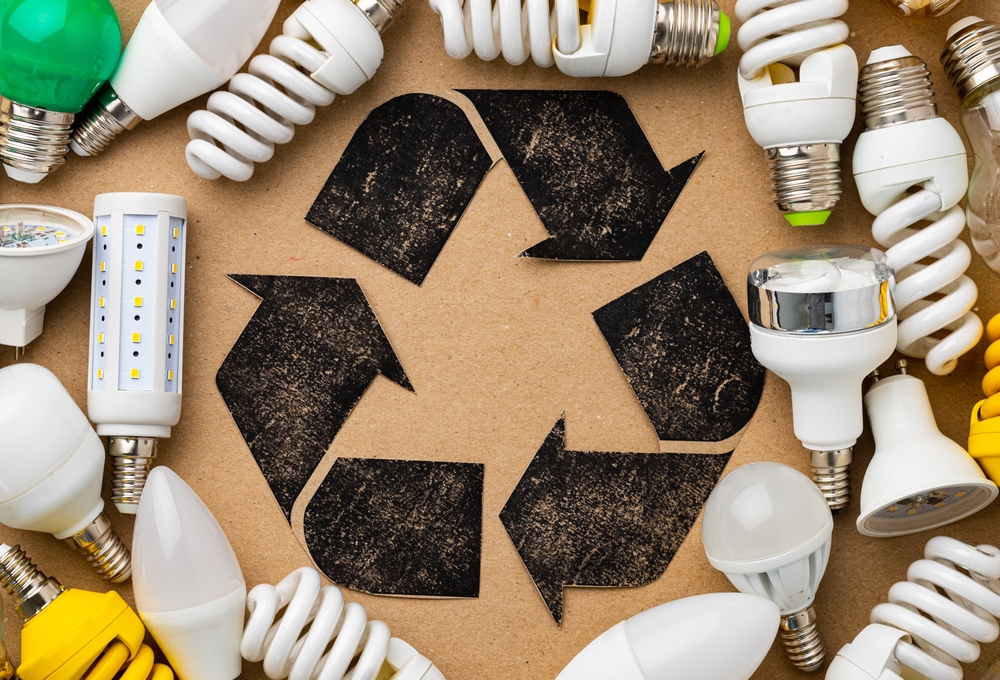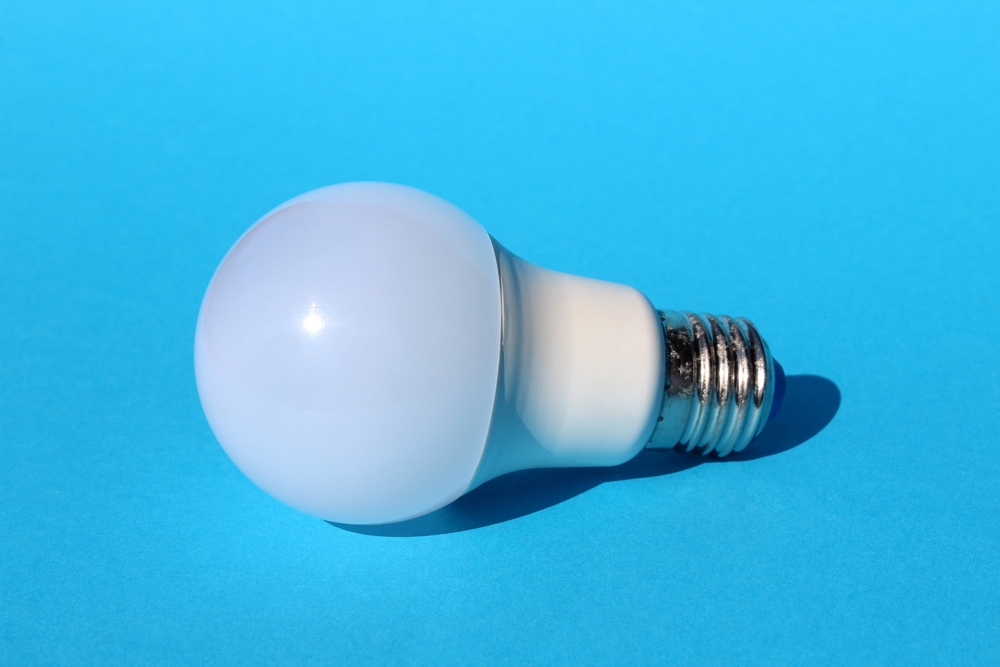When it comes to lamps and light fixtures, we don’t really pay attention to what’s on the inside: the light bulb. That should change — especially if you’re trying to save money on your electric bills. There’s so much to consider, from design to wattage, so finding the proper bulb for your house is more than just picking the cheapest box at the store. Which bulb is right for your home? Let’s compare the most common types and their ideal usage.
- What to Look for in a Light Bulb
- Is Your Light Bulb Compatible? How to Find the Right Size, Voltage, and Amperage
- Types of Light Bulbs
- Fluorescent Light Bulbs
- Halogen Light Bulbs
- LED Light Bulbs
- Comparing Types of Light Bulbs
- What Is the Best Type of Light Bulb?
What to Look for in a Light Bulb, in Plain English
Shopping for light bulbs means dealing with some jargon and technical details. You’ll have to consider wattage and sizes; choose between “incandescent,” “LED,” and “halogen” bulbs; and so on. But, at its most basic, finding the right light bulb just means deciding where you stand on a few factors.
First up, your necessities:
- Size: Your bulb needs to fit your light fixture, of course! Look for letters and numbers on your light fixture and match them to the light bulbs you’re considering; we’ll talk more about this in just a moment.
- Voltage and wattage: Your light fixture is designed to send a certain amount of power to your light bulb. Match up these numbers! If you insert a bulb that’s too powerful into a socket, you can damage your device or even start a fire. Conversely, putting a bulb that’s weaker than the light fixture requires isn’t as dangerous; however, it probably won’t give you your desired lighting.
Once you’ve narrowed down your choices to the bulbs that you can actually use with your lighting fixture, it’s time to decide on some personal preferences:
- Brightness: This, of course, is how much light you want your bulb to generate. Light bulbs measure this in “lumens.”
- Warmth (“color temperature”): You can think of this as the tint of a light; this can vary from “soft” and “warm” orangey lights to relatively harsh white light.
- Shape: Certain shapes may be appropriate for certain fixtures; for example, you might use smaller bulbs with a tapered shape in a chandelier.
- Energy use: This mostly comes down to what type of bulb you get, which we’ll cover later in this article. Some draw less power than others to achieve the same brightness.
- Bulb life: This is simply how long the light bulb is supposed to last.
- Price: Compare this to bulb life and energy use to see what the best deal is for you.
Depending on your feelings about these factors, you may find yourself considering different types of light bulbs — we’ll talk about those in just a moment.
Is Your Light Bulb Compatible? How to Find the Right Size, Voltage, and Amperage
The three nonnegotiables of bulb buying are size, voltage, and amperage. Luckily, it’s generally very easy to figure out what you need in these departments. Just look at your lighting fixture, as it should offer these details on a label of some kind.
Here’s a picture of such a label on a lamp in my house:
The label specifies “Type A,” which refers to the size and shape of the base of the light bulb: the metal part that screws into the fixture. If I want to replace this light bulb, I need to find a “Type A” bulb; otherwise, the new bulb won’t fit!
The label also tells me that the maximum amperage I can use is 100 watts. Anything more than that and the greedy bulb will overheat and possibly damage my lamp or even burn down my home — neither of which I would consider ideal.
Notice that labels don’t always bother to tell you about voltage. When in doubt, assume that you’re looking for a 120V bulb; fixtures that require more unusual voltage will generally tell you so. Voltage isn’t as much of a safety concern as amperage. For example, if you put a 130V bulb in a 120V socket, it will just give you a bulb that runs slightly cooler; if you get a 12V pump for a 120V socket, it will probably just blow out the bulb. However, the latter probably won’t damage the fixture nor burn down your house.
If you can’t find the label or would like more details — such as the voltage, in this example — try searching Google for your fixture’s info. Or, if applicable, you can contact the experts who installed it.
Types of Light Bulbs
When shopping for light bulbs, you’ll have to choose between different types of light bulbs that work in different ways. Here’s what you need to know about types of bulbs and which one you should get. Hint: It’s probably the LED bulb.
Incandescent Light Bulbs
Incandescent light bulbs are the classic bulbs that you probably grew up with — think “light bulb emoji” or “cartoon idea bubble.” These are bulbs with a little filament inside that glows as electricity flows through it. They typically die when that filament gives out.
Incandescent bulbs are incredibly common and cheap, but they aren’t the most environmentally friendly. They require more power to reach the same brightness as fluorescent bulbs. They typically last about a year before dying, and dead bulbs aren’t recyclable. They’re cold-resistant and dimmable, but they also waste energy by releasing excess heat.
Even their availability will soon be a thing of the past. In 2022, the U.S. Department of Energy changed the energy standards for light bulbs. Incandescent bulbs fall short of the new regulations. In August 2023, the ban on manufacturing and selling incandescent bulbs went into effect. If you think you’ve seen them since, you’re not going crazy. There are many exceptions to the ban: bulbs of certain amperages; for lamps, smaller fixtures, appliances, and bug lights; and more.
Fluorescent Light Bulbs

Fluorescent bulbs are fast replacing incandescent bulbs as the most common variety. They’re more energy-efficient than incandescent bulbs because they’re capable of producing more lumens with less wattage.
Fluorescent bulbs are ideal for areas that need to be brightly lit for extended periods of time; plus, they’re also recyclable after they burn out. However, it’ll be a while before that happens; they last for roughly 14 years!
Fluorescent bulbs are filled with mercury vapor, so you’ll want to be careful with them. If they break, keep kids and pets away from the mess and clean up carefully — preferably while wearing gloves. There’s not a ton of mercury in these things, but it’s worth taking a little extra care with them.
Fluorescent bulbs can also emit UV light, though you’ll commonly find that indoor bulbs are coated to block this spectrum.
Halogen Light Bulbs
Halogen bulbs are more of a specialty bulb. You probably wouldn’t use one indoors for a lamp or a chandelier.
Essentially, these bulbs work just like incandescent bulbs — i.e., by heating up a filament to create light — but they add halogen gas into the mix. When a halogen light bulb’s tungsten filament heats up, it reacts with the halogen gas; this forms a compound that’s attracted to the filament. Basically, the halogen in there cleans and reinforces the filament, giving halogen bulbs longer lifespans compared to regular incandescent bulbs.
Halogen bulbs can be very powerful and bright, so they’re not used too often in simple home applications. Floodlights and searchlights typically use halogen bulbs; some car headlights use them, too.
At home, you’d probably only use a halogen bulb for an outdoor floodlight fixture. Or you might use them for a bright overhead light at a workbench, a heat lamp for a cold-blooded pet, or a grow lamp for indoor gardening.
Halogen bulbs function the same way as incandescent bulbs, but they’re not affected by the 2023 ban. Halogen light bulbs meet the standards set by the Department of Energy and will continue to be manufactured and sold.
LED Light Bulbs

“LED” stands for “light-emitting diodes.” These are relatively high-tech bulbs: They use a microchip to light up tiny “diodes,” which are one-way semiconductor devices. When LEDs are turned on, a semiconductor emits visible light. A translucent cap on the bulb makes it look “light-bulb shaped” and hides the multiple light sources within it.
This technical stuff isn’t the point, though — the bottom line for consumers is that LEDs are very, very efficient. They can be up to 90 percent more efficient than the old incandescent bulbs — meaning they take only about one-tenth of the power to equally light up a room. Depending on the type of light, how often you use it, and how much you’re paying for power, you can expect to save something like $5 in energy a year for each LED bulb you use.
And LEDs last a very long time. They won’t “burn out” like other bulbs, and they can take as many as 30 years or more to actually fail or break in a meaningful way. That said, LEDs can get dimmer over time, so you may find yourself replacing these bulbs in five or 10 years if they’re no longer lighting up your space as much as you’d like.
The most meaningful downside of LED lighting is that the bulbs are more expensive; however, you’ll likely recoup that cost pretty quickly in the savings you’ll get on energy and from not having to replace the bulb as often.
LEDs are everywhere in our world today. You’ll find them in streetlights, car headlights, TVs, and, of course, indoor lighting fixtures.
Comparing Types of Light Bulbs
We’ve compiled the following chart featuring each kind's highlights and lowlights — no pun intended.
Type of Bulb | Incandescent | Fluorescent | Halogen | LED |
Lumens per watt | 15 | 60 | 25 | 72 |
Bulb life | 1,000 hours | 10,000 hours | 3,000 hours | 25,000 hours |
Recyclability | No | Yes | No | No |
Contains mercury | No | Yes | No | No |
Instant on | Yes | Varies | Yes | Yes |
Dimmable | Yes | Varies | Yes | Varies |
What Is the Best Type of Light Bulb?
From a purely technical standpoint, LED light bulbs are the superior option. Their longevity and overall brightness make them optimal for everyday use. The color-changing variants and other features also offer their own appeal. Anybody looking to set up mood lighting or a timer should consider LED bulbs.
LEDs end up paying for themselves over time, but that doesn’t erase the up-front cost. And if you’re looking to grab a pack of bulbs at the local grocery store, you may struggle to find LED bulbs. In this scenario, fluorescents are a more-than-adequate substitute. Yes, the potential exposure to mercury vapor is worrying, but they produce only slightly less light than LED bulbs for the same amount of wattage. But they last considerably longer than incandescent or halogen bulbs, and they’re recyclable when they burn out. Simply put, fluorescent will make do if you can’t use LED bulbs.


